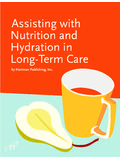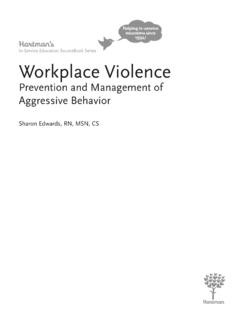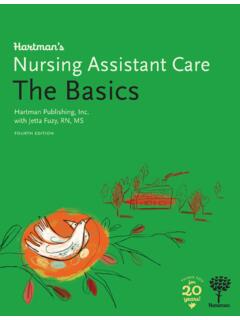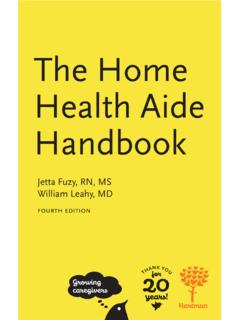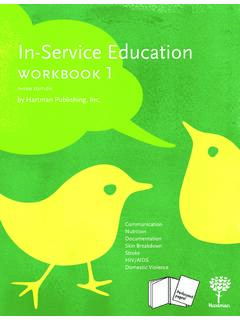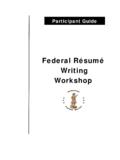Transcription of Preventing Abuse & Neglect - hartmanonline.com
1 Helping in-service educators since 1994!Hartman's In-Service Education SourceBook SeriesPreventingAbuse & NeglectA Guide for CaregiversPreventingABUSE & NEGLECTA Guide for CaregiversJetta Fuzy, RN, MSDirector of Education & TrainingHealth Education, Lauderdale, FloridaThe publisher gratefully acknowledges the following individuals who contributedto this material:Lorinda A. Ferland, RNStaff Development Consultant to Long Term CareAlameda, CAKathleen M. Litz, RN IINurse ConsultantLaTroy M. Navaroli, BS, RN, CRRNW arren, PAAlbuquerque, NMNOTICE TO THE READERT hough the guidelines contained in this text arebased on consultations with health care professionals, theyshould not be considered absolute recommendations. Theinstructor and readers should follow employer, local,state, and federal guidelines concerning health carepractices. These guidelines change, and it is the reader'sresponsibility to be aware of these changes and of thepolicies and procedures of her or his health publisher, author, editors, and reviewerscannot accept any responsibility for errors or omissions orfor any consequences from application of the informationin this book and make no warranty, express or implied,with respect to the contents of this does not warrant or guarantee any ofthe products described herein or perform any analysis inconnection with any of the product information : Jetta Fuzy, RN, MSDevelopment Editor: Celia McIntireComposition: Celia McIntireDesign: John W.
2 DavisIllustration: Mike RamosISBN 1-888343-19-2 1998 Hartman Publishing, Inc. Allrights reserved. Limited permission tophotocopy the labeled handouts in thistext is granted to direct purchasers of thisbook from the publisher. Copies canonly be made for employees orstudents at ONE LOCATION of amulti-site employer or school. No otherpart of this book may be reproduced, inany form or by any means, withoutpermission in writing from the of ContentsFYI5 Introduction and Assessment7 Handout Intro-1 Assessment A (pg. 8)Handout Intro-2 Assessment A Answer Key (pg. 9)Handout Intro-3 Key Terms (pg. 10)Handout Intro-4 Note-Taking Worksheet (pg. 11)Learning Objective 1: Define Abuse and neglect15 Transparency 1-1 Types of Abuse and Neglect (pg. 18)Handout 1-1 Name the Abuse or Neglect (pg. 19)Learning Objective 2: Describe signs of Abuse and neglect21 Handout 2-1 Signs of Abuse and Neglect (pg. 23)Transparency 2-1 Suspicious Injuries (pg.)
3 24)Transparency 2-2 Signs of Abuse (pg. 25)Transparency 2-3 Signs of Neglect (pg. 26)Learning Objective 3: Describe persons who are most vulnerableto Abuse or Neglect by caregivers27 Handout 3-1 Who is Vulnerable to Abuse or Neglect ? (pg. 28)Transparency 3-1 Who is Vulnerable to Abuse or Neglect ? (pg. 29)Learning Objective 4: Identify factors that contribute toincreased stress among caregivers30 Transparency 4-1 Stressful Situations (pg. 33)Transparency 4-2 Negative Attitudes (pg. 34)Transparency 4-3 Dealing With Stress (pg. 35)Transparency 4-4 Helping Family Members With Stress (pg. 36)Handout 4-1 Discussion Time (pg. 37)Learning Objective 5: Describe the proper response of healthcaregivers to suspected Abuse and neglect38 Transparency 5-1 Your Responsibilities (pg. 40)Learning Objective 6: List ways that caregivers can help preventor stop Abuse and neglect41 Transparency 6-1 Preventing Abuse and Neglect (pg.
4 42)Closing and Assessment43 Handout Closing-1 Assessment B (pg. 45)Handout Closing-2 Assessment B Answer Key (pg. 48)References49In-Service Evaluation Form50 Certificate of Completion51 Record Keeping Form52 For More Information535 FYIhis in-service covers Abuse andneglect in the health care extent of adult Abuse in thiscountry is shocking. Precisely howmany adults are unable to provide for theirown protection, and are victims of Abuse , Neglect , or exploitation by their caregiversor family, is subject to question. There is nodoubt, however, that the incidence of adultabuse far exceeds the number of reportedcases. Though Abuse , Neglect , andexploitation of older persons or disabledadults is only slightly less widespread thanchild Abuse , it is far less likely to of physical Abuse of adults over65 vary widely, from four percent to as highas twenty-five percent. Translated intohuman terms, these statistics suggest thatfrom one to six million adults are abusedeach year.
5 (Source: Communication onAging, 1990.) More than half of these adultssuffer psychological Abuse as well,including verbal assault, threats, fear, orisolation. Psychological Abuse is generallyconsidered to be the most common of allforms of adult assistants and home health aidesshould be conscious of their own behaviorwhen caring for others. Many things canaffect caregivers and lead to Abuse orneglect of the people in their care, includingstress, difficult behaviors, improper training,understaffing, and personal or culturalattitudes about violence. This in-serviceshould allow your participants to explorethose factors and understand how they canaffect the care they give to others. Duringthis in-service be certain your participantsclearlyunderstand their responsibilities whendealing with suspected Abuse or : If at all possible, this in-serviceshould be conducted in a "safe" environmentso that your participants feel free to openlydiscuss their concerns about Abuse note that limited permission isgranted to photocopy the handouts for use atthe site originally purchasing this other parts of this in-service,including the lesson plan, is use the handouts, photocopy the numberneeded for your group.
6 Consider usingdifferent colors of paper to organize thedifferent handouts or to make some transparency masters to acetates foruse with an overhead projector. You can dothis by purchasing transparency film at anoffice supply store and photocopying thetransparency masters onto the acetates, oryou can have a copy company do it for overhead projection is not convenient foryour presentation area, you may wish tocopy the information from the transparencymasters onto a chalkboard or flip hope you find this in-service , as always, we welcome yourcomments and Plan - Introduction & AssessmentIntroduction and AssessmentEstimated Time:10-15 minutesTools:Handout Intro-1 Assessment AHandout Intro-2 Assessment A Answer KeyHandout Intro-3 Key TermsHandout Intro-4 Note-Taking WorksheetLearning Activity:AssessmentNOTE: Before teaching this in-service, the instructor must find outwhether your state requires health care workers to report suspectedabuse and Neglect .
7 On the answer key, question #1, write true or false,depending on your state's Intro-1 Assessment AAsk the participants to complete the assessment. If you decide to usethis assessment as a post-test at the end of the in-service, withhold theanswers for now. Use the assessment to lead into a discussion ofdomestic Intro-3 Key TermsGo over the key terms as Intro-4 Note-TakingWorksheetEncourage participants to take notes during the lecture, as this will helpthem learn and remember the Intro-1 Assessment AName: _____ Date: _____Write (T) True or (F) False for each of the following My state requires health care workers to report suspected Abuse on the Health care workers should report suspected Abuse , whether their states requirethem to or The words "passive Neglect " mean not caring for another person on Over 1,000,000 elderly adults are abused and exploited every Caregivers who Abuse the people in their care cannot change the way they There is no point in reporting suspicions of Abuse or Neglect to the supervisor,because it costs too much and it doesn't do any The people most vulnerable to adult Abuse and Neglect are the elderly, mentallyand physically ill, and developmentally Screaming and yelling are kinds of To help prevent Abuse or Neglect , the elderly should maintain friendships, inviteguests over often.
8 And keep control of their own Caregivers who are under a lot of stress are less likely to Abuse or Neglect thepersons in their Intro-2 Assessment A Answer "Passive Neglect " means not caring for another person because you do not knowhow to care for this person. "Active Neglect " means purposely not caring for And the number keeps Caregivers can learn how to change their attitudes and the way they deal with thepeople in their There is no way the health care system can solve the problems of Abuse andneglect if no one reports All of these actions can help the elderly remain as independent as Stress plays a big part in Abuse and Neglect . Caregivers who are under a lot ofstress are many times unable to cope with their emotions very well, and this can lead toabuse and Intro-3 Key TermsAbuse: Purposely causing physical,mental, or emotional pain or injury tosomeone in your Neglect : Purposely harming aperson physically, mentally, or emotionallyby failing to provide needed care.
9 Examplesinclude deliberately leaving a bedriddenperson alone for lengthy periods, ignoringthe person, or willfully denying the personfood, medication, dentures, or : Keeping informationabout the persons in your care and theirfamilies only among people who are directlyinvolved with their Abuse : Stealing, exploiting, orimproperly using the money, property, orother assets of another : Harming the person in your careeither physically, mentally, or emotionallyby failing to provide needed Neglect : Unintentionallyharming a person physically, mentally, oremotionally by failing to provide neededcare. Caregiver may not know how toproperly care for the person, or may notunderstand the person's Abuse : Physically harming aperson through such actions as slapping,bruising, cutting, burning, physicallyrestraining, pushing, shoving, or even Abuse : Emotionallyharming a person by demeaning,frightening, humiliating, intimidating,isolating, insulting, treating him or her as achild, or by using verbal or Neglect : Any of theactivities mentioned above committed by theperson Abuse : Sexually harming a personby molesting or Burns: Burns created when apart of the body is held in scalding water.
